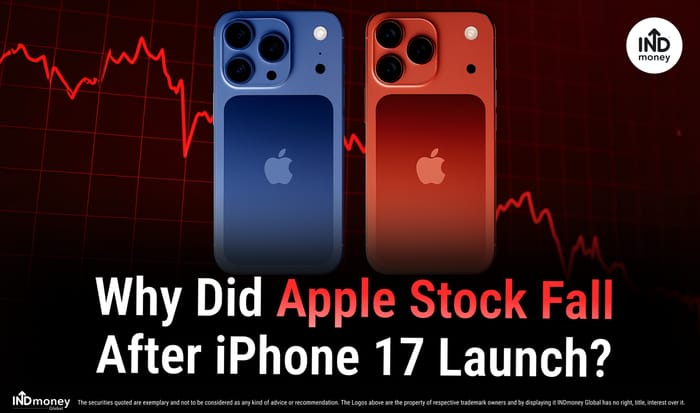
- What Was Launched at the iPhone 17 Event
- Why Did Apple Stock Fall After The Launch?
- Historical Reaction: Apple Stock Around Launches
- What Should Apple Investors Focus On?
- The Takeaway for Investors After iPhone 17 Launch
Apple unveiled its highly anticipated iPhone 17 series at an “Awe-Dropping” fall launch event on September 9, 2025. But investor excitement quickly turned to caution, and Apple share price fell 1.5 %, closing at $234.35 as per Google Finance, marking a notable dip in the company’s valuation.
Analysts estimate this translates to a loss of tens of billions of dollars in market value almost instantly. Let’s dive into what might have disappointed investors and triggered the sell-off.
What Was Launched at the iPhone 17 Event
Here’s a clear breakdown of the new products Apple announced:
| Product | Key Features |
| iPhone 17 | New A19 chip, AI enhancements, better cameras, longer battery life |
| iPhone Air | Ultra-thin titanium frame (5.6 mm), next-gen performance, sleek design |
| iPhone 17 Pro / Pro Max | Flagship specs with Pro motion, photography enhancements |
| Apple Watch SE 3, Series 11, Ultra 3 | Updated health sensors and features |
| AirPods Pro 3 | Live language translation feature |
Source: Apple Event, Reuters
Why Did Apple Stock Fall After The Launch?
Here are the main reasons the stock slid post-event:
- “Sell-the-news” syndrome: Most features had leaked ahead of time. With expectations already priced in, the reveal lacked surprise and failed to energize the market
- Margin pressure from tariffs: Apple absorbed over $1 billion in U.S. tariff costs while holding stealthily flat prices, raising investor concerns about squeezed profit margins.
- Lack of AI breakthrough: With AI the buzziest tech topic, Apple offered only modest enhancements, and its public-facing AI strategy remains vague, with meaningful updates possibly delayed into 2026.
Historical Reaction: Apple Stock Around Launches
Apple often experiences short-term pullbacks after major events, despite longer-term gains. Here’s the pattern as seen in prior product cycles:
- Typical short-term move: On average, Apple’s share price falls about 0.2 % on the day of an iPhone announcement. In the month that follows, stock tends to rebound approximately 2.8%, according to Barron's
- 2007 First iPhone case study: The day after launch, the stock rose just 0.07 %, but surged nearly 16 % in the month afterward, as per Dividend.com.
A Reddit comment reflected this recurring pattern. “Based on past performance, Apple's stock price may drop initially after the new products launch, but it tends to rebound and climb higher over time.” a redditor wrote.
What Should Apple Investors Focus On?
The iPhone 17 launch shows that short-term stock reactions can be noisy. For long-term investors, it’s more important to track Apple’s core business levers and industry position. Three areas stand out:
- Global Market Share: Counterpoint Research shows Apple at 19% of worldwide shipments in Q1 2025, briefly ahead of Samsung. Sustaining this, especially in China and India, will be key.
- Premium Segment: Apple controls 60–62% of smartphones priced above $400, supporting margins and loyalty. The test is whether new models can keep this pricing power amid tariffs and rising costs.
- Services Growth: Apple’s services (App Store, iCloud, Music, Pay) continue to grow at double-digit, high-margin rates. A slowdown here would be a bigger red flag than short-term device cycles.
Together, these factors will matter far more to Apple’s valuation than one-day stock moves after product launches.
The Takeaway for Investors After iPhone 17 Launch
Apple’s stock dip after the iPhone 17 event reflects classic sell-the-news dynamics, investor hunger for bold AI innovation, and concerns about squeezed margins. For investors, the key is to watch:
- How tariffs and cost pressures evolve in earnings updates.
- Any announcements around genuine AI breakthroughs or new services growth.
- Real-world demand trends for the iPhone 17 lineup, especially in rising markets.
If Apple turns its innovation-driven momentum back up, short-term drops may prove to be buying opportunities and not red flags.
Disclaimer:
The content is meant for education and general information purposes only. Investments in the securities market are subject to market risks, read all the related documents carefully before investing. Past performance is not indicative of future returns. The securities quoted are exemplary and are not a recommendation. This in no way is to be construed as financial advice or a recommendation to invest in any specific stock or financial instrument. The figures mentioned in this article are indicative and for general informational purposes only. Readers are encouraged to verify the exact numbers and financial data from official sources such as company filings, earnings reports, and financial news platforms. The Company strongly encourages its users/viewers to conduct their own research, and consult with a registered financial advisor before making any investment decisions. All disputes in relation to the content would not have access to an exchange investor redressal forum or arbitration mechanism. Registered office address: Office No. 507, 5th Floor, Pragya II, Block 15-C1, Zone-1, Road No. 11, Processing Area, GIFT SEZ, GIFT City, Gandhinagar – 382355. IFSCA Broker-Dealer Registration No. IFSC/BD/2023-24/0016, IFSCA DP Reg No: IFSC/DP/2023-24/010